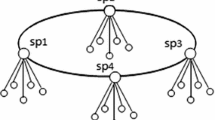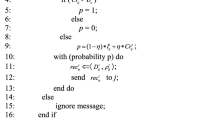Abstract
Security is a critical constraint for the expansion of Peer-to-Peer (P2P) networks. The autonomy, dynamic and distribution natures benefit both valid and malicious users and also lead that P2P networks are extremely susceptible to malicious users. Exploiting a reputation-based trust model is a feasible solution in such an open environment to build trust relationship among peers. While most of existing trust models focus on restraining the abuse and malicious attacks, intentions and sharing capabilities of peers are mostly ignored. In this paper, we present a self-nominating trust model based on hierarchical fuzzy systems to quantify the behaviors of peers. The reputation is defined based on eight factors, where three promising factors are provided by resource holders to demonstrate their desires, and four capability factors are recorded by requesters to identify the provider’s service capability. The approach degree based updating recommendation is deployed to aggregate the global trust metrics. Experimental results illustrate that our trust model effectively improves the efficiency and security of P2P systems.







Similar content being viewed by others
References
Marmol FG, Perez GM (2009) Security threats scenarios in trust and reputation models for distributed systems. Comput Secur 28:545–556
Selvaraj C, Anand S (2012) A survey on security issues of reputation management systems for peer-to-peer networks. Comput Sci Rev 6:145–160
Sergio M, Hector GM (2006) Taxonomy of trust: categorizing P2P reputation systems. Comput Netw 50:472–484
Kamvar SD, Schlosser MT, Hector GM (2003) Eigenrep: reputation management in P2P networks. In: Proceedings of 12th International World Wide Web Conference, vol 1 , pp 123–134
Wang HY, Wang F, Liu JC, Lin C, Xu K, Wang CG (2013) Accelerating peer-to-peer file sharing with social relations. IEEE J Sel Areas Commun 31(9):66–74
Zhu HJ, Du SG, Gao ZY, Dong MX, Cao ZF (2014) A probabilistic misbehavior detection scheme toward efficient trust establishment in delay-tolerant networks. IEEE Trans Parallel Distrib Syst 25(1):22–32
Zhu HJ, Lin XD, Lu RX, Fan YF, Shen XM (2009) SMART: a secure multilayer credit-based incentive scheme for delay-tolerant networks. IEEE Trans Veh Technol 58(8):4628–4639
Zadeh LA (1965) Fuzzy sets. Inf Control 8:338–353
Lai PKY, Chow KP, Hui LCK, Yiu SM (2014) Modeling the initial stage of a file sharing process on a BitTorrent network. Peer-to-Peer Netw Appl 7(4):311–319
Qiu D, Srikant R (2004) Modeling and performance analysis of bit torrent-like peer-to-peer networks. In: Proceedings of ACM SIGCOMM, pp 367–378
Feldman M, Padimitriou C, Chuang J, Stoica I (2006) Free-riding and whitewashing in peer-to-peer systems. IEEE J Sel Areas Commun 24(5):1010–1019
Carra D, Michiardi P, Salah H, Strufe T (2013) On the impact of incentives in eMule analysis and measurements of a popular file-sharing application. IEEE J Sel Areas Commun 31(9): 94–104
Damiani E, Vimercati SDCD, Paraboschi S, Samarati P (2003) Managing and sharing servents reputations in P2P systems. IEEE Trans Knowl Data Eng 15(4):840–854
Dou W, Wang HM, Yan J, Peng Z (2004) A recommendation-based peer-to-peer trust model. J Softw 15(4):571–583
Xiong L, Liu L (2004) PeerTrust: supporting reputation-based trust for peer-to-peer electronic communities. IEEE Trans Knowl Data Eng 16(7):843–857
Song SS, Hwang K, Zhou RF, Kwok YK (2005) Trusted P2P transactions with fuzzy reputation aggregation. IEEE Internet Comput 9(6):24–34
Chen HW, Ye ZW (2008) Research of P2P trust based on fuzzy decision-making. In: Proceedings of 12th International Conference on Computer Supported Cooperative Work in Design, pp 793–796
Lin HQ, Li ZT, Huang QF (2011) Multifactor hierarchical fuzzy trust evaluation on peer-to-peer networks. Peer-to-Peer Netw Appl 4(4):376–390
Raju GVS, Zhou J, Kisner RA (1991) Hierarchical fuzzy control. Int J Control 54(5):1201–1216
Wang LX (1999) Analysis and design of hierarchical fuzzy systems. IEEE Trans Fuzzy Syst 7(5):617–624
Lazzerini B, Marcelloni F (2006) A hierarchical fuzzy clustering-based system to create user profiles. Soft Comput 11(2):157–168
Mohammadian M (2005) Innovative design of adaptive hierarchical fuzzy logic systems. In: Proceedings of the 2005 International Conference on Computational Intelligence for Modelling, Control and Automation, and International Conference on Intelligent Agents, Web Technologies and Internet Commerce , pp 1072–1079
Rattasiri W, Halgamuge SK (2003) Computationally advantageous and stable hierarchical fuzzy systems for active suspension. IEEE Trans Ind Electron 50(1):48–61
Lopes N, Couto P, Jurio A, Pedro MP (2013) Hierarchical fuzzy logic based approach for object tracking. Knowl-Based Syst 54:255–268
Lotfi M, Ghaderi S (2013) Coordination between long-term decision process and day-ahead unit commitment in deregulated markets: a fuzzy hierarchical bi-level modeling approach. Appl Math Model 37(7):5511–5527
Saroiu S, Gummadi PK, Gribble SD (2002) Measurement study of peer-to-peer file sharing systems. In: Proceedings of SPIE Multimedia Computing and Networking, pp 156–170
Zhou RF, Hwang K (2007) PowerTrust: a robust and scalable reputation system for trusted peer-to-peer computing. IEEE Trans Parallel Distrib Syst 18(4):460–473
Acknowledgments
This work is supported by the NSFC (Grant No. 61271172 and 61372085), RFDP (Grant No. 20120185110030, 20130185130002 and 20120185110025), SRF for ROCS, SEM 863 high technology plan (Grant No. 2015AA01A707) and Sichuan International Corporation Project (Grant No. 2013HH0005).
Author information
Authors and Affiliations
Corresponding author
Rights and permissions
About this article
Cite this article
Han, Q., Wen, H., Feng, G. et al. Self-nominating trust model based on hierarchical fuzzy systems for peer-to-peer networks. Peer-to-Peer Netw. Appl. 9, 1020–1030 (2016). https://doi.org/10.1007/s12083-015-0365-8
Received:
Accepted:
Published:
Issue Date:
DOI: https://doi.org/10.1007/s12083-015-0365-8




